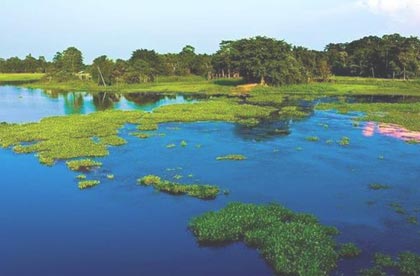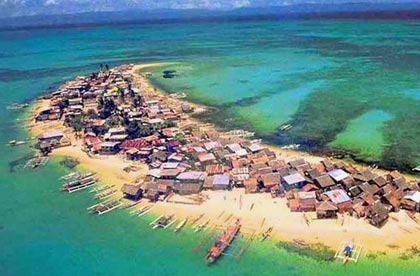Majuli is the world's largest river island and is located in the northeastern state of Assam. Nestled in the mighty Brahmaputra River, Majuli is renowned for its stunning natural beauty, vibrant culture, and spiritual significance. In the 20th Century, it spanned an area of approximately 880 sq km. However, over time, the size has dwindled due to erosion. The island is home to a rich Assamese cultural heritage and a unique blend of traditional practices and environmental significance. In 2016, Majuli was officially recognized as the world’s largest river island and was made a district, further elevating its status as a must-visit destination.
This unique formation is located about 40 km from Jorhat, the nearest significant city to Majuli Island. Over centuries, the river’s shifting channels have shaped Majuli into its present form, and today it covers an area of about 880 sq km, although erosion has reduced its size significantly over the years. The island is accessible by ferry from Jorhat, with multiple ferries running throughout the day. Majuli is divided into numerous small villages and hamlets, with the Mising, Deori, and Assamese people forming the majority of the population.
The island's landscape is characterised by lush greenery, water bodies, and paddy fields, making it a peaceful and serene location. During the monsoon season, large parts of Majuli get submerged, leaving behind fertile soil, making it an important agricultural region in Assam.
How to Reach - Since Jorhat is the nearest town to Majuli Island, either train or flights from Guwahati take tourists to Jorhat. From there, the rest of the journey has to be done by road.


Majuli has a deep-rooted cultural and historical significance. The island has been the cultural capital of Assam since the 16th century and is considered the epicentre of Vaishnavism, a monotheistic branch of Hinduism that was propagated by the revered saint and reformer, Srimanta Sankardeva. In the 15th century, Sankardeva, along with his disciple Madhavdeva, established several satras (monastic institutions) on the island, which became centres of religious, cultural, and artistic activities. These satras play a crucial role in preserving the traditional music, dance, and literature of Assam.
The monks of these satras practise ancient forms of music and dance, including the Bhaona (a form of religious theatre) and Sattriya dance, which is one of the eight classical dance forms of India. The festivals and rituals observed in the satras attract devotees and tourists alike, with Raas Mahotsav, a festival celebrating Lord Krishna, being one of the most significant events held on the island.
Majuli is known not only for its cultural richness but also for its ecological diversity. The island's wetlands, riverine forests, and water bodies provide a haven for a variety of wildlife, particularly migratory birds. It is home to several endangered and rare species of birds, making it a paradise for birdwatchers and nature enthusiasts.
The island also supports sprawling rice fields and groves of bamboo, banana, and sugarcane. Rice cultivation is the primary livelihood for the residents of Majuli, with several unique varieties of rice, such as Komal Saul and Bao Dhan, grown in the region. The islanders also engage in fishing and handloom weaving, with intricate traditional Assamese fabrics being one of the local specialties.
However, despite its natural beauty and biodiversity, Majuli faces significant environmental challenges, with erosion being the most pressing issue. The Brahmaputra River's powerful currents have gradually eaten away large portions of the island over the years, reducing its size considerably.
Satras Majuli is home to around 22 active satras, the most prominent being the Auniati Satra, Dakhinpat Satra, and Garmur Satra. These monastic institutions are open to visitors, offering a glimpse into the island’s religious and cultural practices. The satras are known for their traditional mask-making, intricate dance dramas, and ancient manuscripts.
Raas Mahotsav One of the island’s biggest attractions is the Raas Mahotsav, a grand celebration of Lord Krishna’s life. Held annually in November, the festival features elaborate performances, including the famed Bhaona plays, which depict scenes from the life of Krishna. The entire island comes alive during this festival, attracting devotees and tourists from across India and abroad.
Bird Watching Majuli is a bird lover’s paradise. The island’s wetlands attract migratory birds from distant regions like Siberia and Europe. Birdwatchers can spot a wide variety of species, especially during the winter months, when the migratory birds make Majuli their temporary home.
Mask Making at Samaguri Satra One of the unique crafts practised in Majuli is traditional mask making, an art form used in religious plays and performances. The Samaguri Satra is famous for producing vibrant, handcrafted masks used in Bhaona performances. Visitors can witness the process of mask-making and even purchase these artistic creations as souvenirs.
Local Handicrafts The island is known for its vibrant handloom and handicraft industry. The indigenous Mising community is particularly famous for their intricate weaving patterns. Tourists can visit the local villages to explore the weaving techniques and purchase beautiful hand-woven textiles like gamochas (traditional Assamese towels) and mekhla chadors (traditional attire worn by Assamese women).